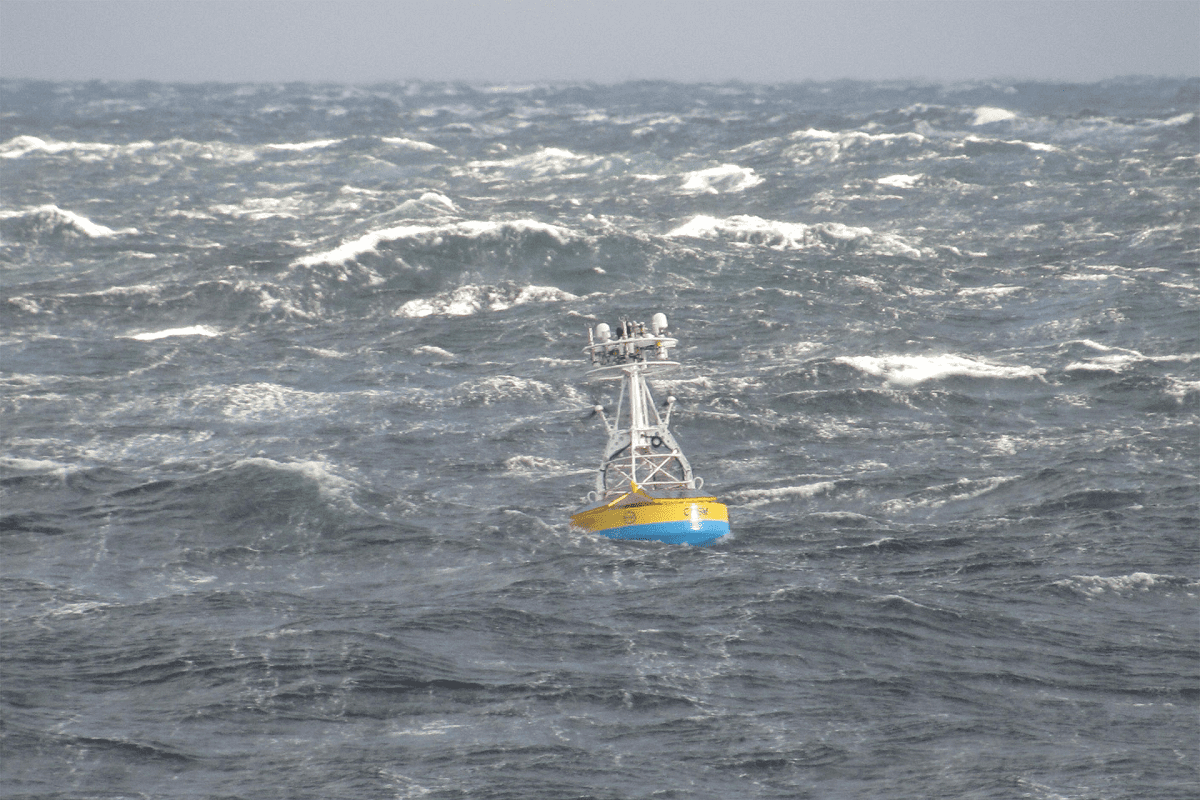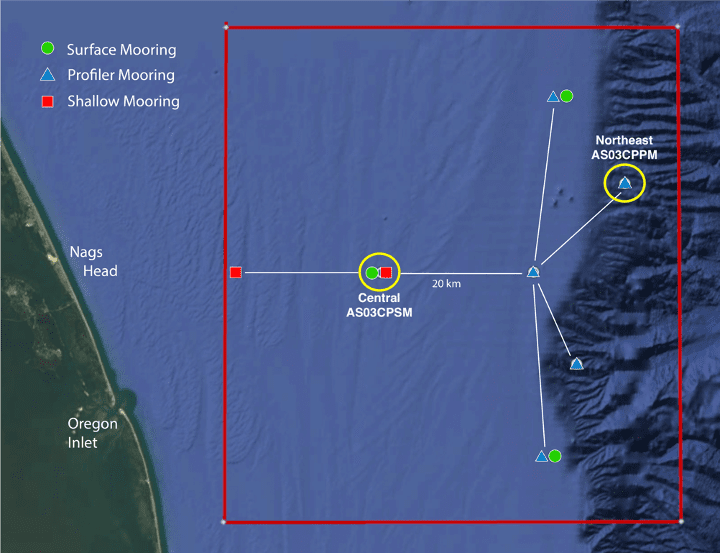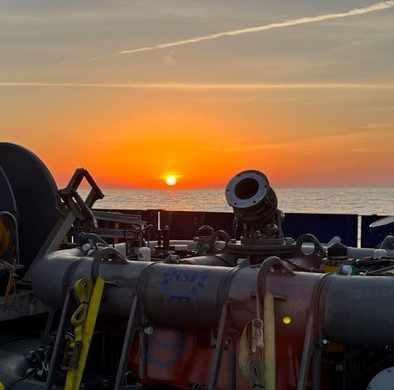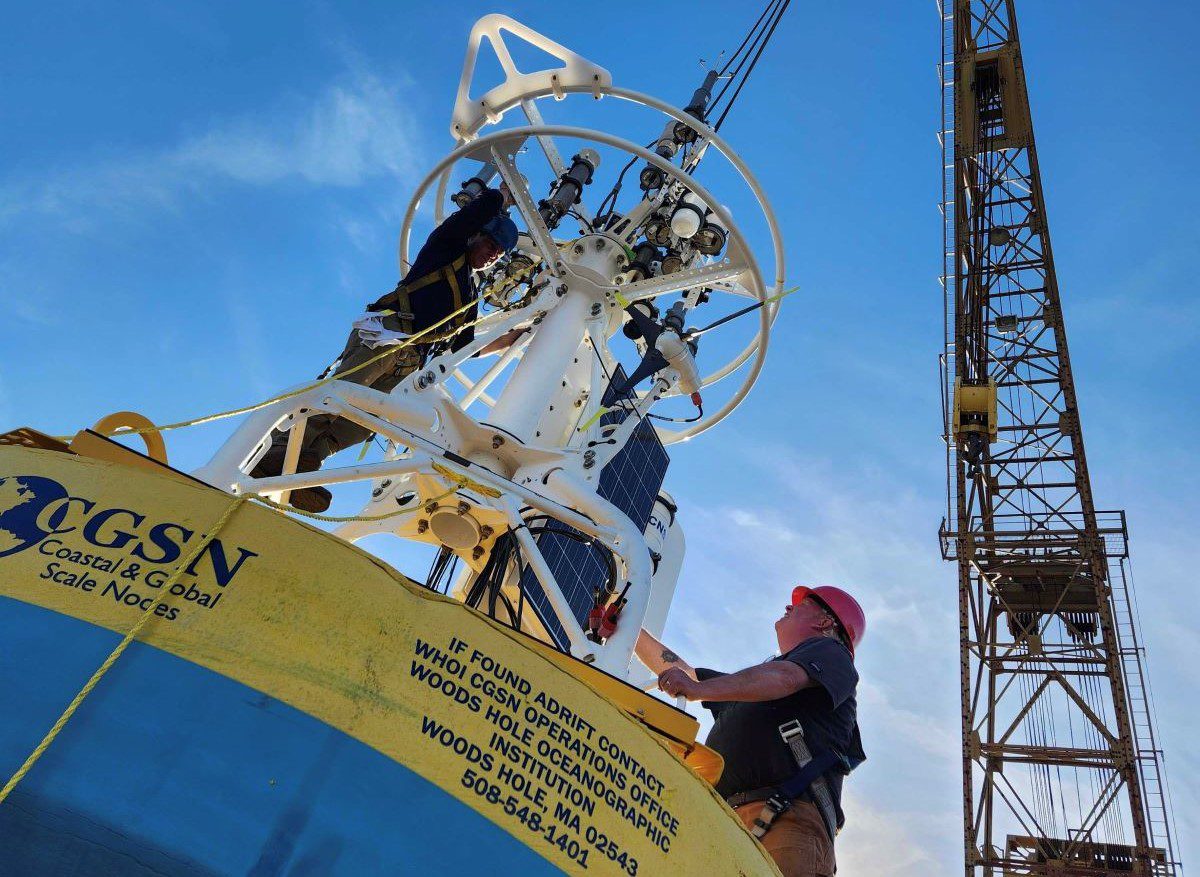
Massachusetts-based Woods Hole Oceanographic Institution scientists and engineers are on their way to deploy test moorings off the coast of Nags Head to better understand conditions before relocating the Ocean Observatories Initiative’s Pioneer Array ocean-observing system, which most recently was collecting data about 75 nautical miles south of Martha’s Vineyard.
The science team headed out Tuesday on the research vessel Neil Armstrong for a test mooring and mapping cruise for the Pioneer Array Mid-Atlantic Bight, or MAB, from where the vessel was in dry dock for a hull inspection at Detyens Shipyard in North Charleston, South Carolina, according to a blog post Tuesday on the Woods Hole Oceanographic Institution website.
Supporter Spotlight
The Ocean Observatories Initiative, which provides free access to a wide range of data collected from around the world’s oceans, is funded by the National Science Foundation through a cooperative agreement with Woods Hole Oceanographic Institution, an independent nonprofit dedicated to ocean research, exploration and education and based in Massachusetts.
“This new Pioneer Array location in the MAB offers many opportunities for scientists to obtain data to further their research, and will provide better insight into conditions in the area for a variety of stakeholders,” Al Plueddemann, project scientist for Ocean Observatories Initiative’s Coastal and Global Scale Nodes group at Woods Hole Oceanographic Institution, said in a statement. “We welcome researchers, educators, and industry members to reach out to us to explore ways we might work together to maximize the usefulness of the data.”

The data collected by observing the ocean can help track, predict, manage and adapt to changes in the marine environment and coastal communities can use the data to prepare for floods and other natural disasters, according to the initiative.
Plueddemann responded to Coastal Review in an email Tuesday evening while underway from Charleston that the data collected will be primarily used for research, but also made publicly available for anyone with an internet connection. “We have had users ranging from high school students to commercial fishers,” he said.

In addition to serving as project scientist for the Pioneer MAB Array, Plueddemann is the senior scientist in the Department of Physical Oceanography at Woods Hole.
Supporter Spotlight
The team will be offshore for a week or so on the Woods Hole Oceanographic Institution’s vessel to map the seabed using sonar, perform remotely operated vehicle visual inspections and deploy the test moorings at two different depths.
A surface mooring designed to examine coastal-scale phenomena and withstand the challenging conditions of shallow coastal environments will be deployed at 30 meters, or about 98 feet deep, according to the initiative.
A coastal profiler mooring will be deployed at 600 meters, or 1,968.5 feet, deep. This type of mooring contains a wire-following profiler that moves through the water column, continuously sampling ocean characteristics from about 75 feet below the surface to 75 feet above the sea floor.
Plans are to collect the test moorings in the fall and prepare to install the Coastal Pioneer Array in 2024.
Once the array is fully operational, the ocean data collected will be available online to anyone with an Internet connection on the website for Ocean Observatories Initiative, a science-driven ocean observing network that delivers real-time data from more than 900 instruments to address critical science questions regarding the world’s oceans.
The two test moorings being deployed now will help the researchers better understand the specific ocean conditions and make sure the Coastal Pioneer Array can withstand the environment.
“We have a good track record with the moorings on the New England shelf, but the MAB moorings will be at different water depths and will experience different environmental conditions (wind, waves, currents). We want to test our mooring designs to ensure they are properly ‘tuned’ to the new location,” Plueddemann responded in the email.

Plueddemann said the array is comprised of instrumented moorings, ocean gliders and propeller-driven autonomous underwater vehicles, often called uncrewed underwater vehicles.
“They work together to observe different space and time scales. For example, an instrumented mooring can do very well resolving time, sampling every few minutes. But at only one location. Ocean gliders do very well covering space, but a lot of time goes by (e.g. a week or more) before they can get another data point at the same location. The combination is more powerful than any one element,” he explained.
The first deployment of the Pioneer Array was off the New England coast at the continental shelf and continental slope interface, where it collected data from 2016 until it was recovered in September 2022.
“Researchers have some very interesting results from the New England array,” Plueddemann said. “In short, the Array was intended to capture the exchange of properties (temperature, salinity, nutrients, …) between continental shelf waters and the deeper waters offshore. That was done successfully, and it was found that important aspects of this exchange happened in ways we had not anticipated.”
Plueddemann said that relocating the Pioneer Array was always part of the plan for Ocean Observatories Initiative. The idea was to deploy for five to seven years in the initial location chosen based on input to National Science Foundation, then go out to the community for input to determine the next location through a series of workshops.
Participants during a series of workshops in 2022 recommended the southern Mid-Atlantic Bight between Cape Hatteras and Norfolk Canyon for the new location.
“This region offers opportunities to collect data on a wide variety of cross-disciplinary science topics including cross-shelf exchange and Gulf Stream influences, land-sea interactions associated with large estuarine systems, a highly productive ecosystem with major fisheries, processes driving biogeochemical cycling and transport, and fresh-water outflows during extreme rain events. The location also offers opportunities to improve our understanding of hurricane development, tracking, and prediction, and to form partnerships with the nascent offshore wind industry,” the Ocean Observatories Initiative said.

Plueddemann said that the area off the Outer Banks is an important region of the US coastal ocean, “and has a vibrant ecosystem associated with complex physical processes. Arguably more complex than the New England site. So, it is challenging to understand the physical processes and how they impact the ecosystem. Yet the same techniques (moorings, gliders, AUVs) used for the New England Array are applicable to observing the MAB. So, relocating the array makes sense, and will likely have a big payoff in terms of new understanding.”
Preparation and testing will continue through this year and the array will initially be deployed in spring 2024.
Plueddemann said that the researchers plan to follow the same timeline as was followed for the original Pioneer Array deployment. The expectation is for the array to be in place for five to seven years and then be relocated again.
“We are still evaluating the land-based needs to maintain the array,” he added.
Across the globe, the Ocean Observatories Initiative has seven total arrays with five currently active.
“We know the ocean is dynamic, changing on time scales from hours to decades. There are many benefits to being able to understand and predict these changes, but if the system is not well understood, the predictions will not be good,” he said. “Researchers don’t currently have a complete enough understanding of how the ocean works, particularly on regional and smaller scales, to make accurate predictions. The OOI infrastructure is meant to provide observations that will help the research community with understanding, thus leading to better prediction.”

Dr. Reide Corbett, executive director of East Carolina University’s Coastal Studies Institute in Wanchese, is enthusiastic about the opportunities the Pioneer Array will bring to the region, the initiative announced Tuesday.
“The cross-shelf suite of instrumentation off northeastern North Carolina’s coast is in a region of complex physics and critical ecosystem dynamics that draws interest from many disciplines and creates opportunities for transformational science. This is also in a region with a growing renewable energy sector, including two active offshore wind leases, with opportunities to partner with the agencies involved,” Corbett explained.
“The Coastal Studies Institute is excited about the observations that will be made from these instruments, allowing us to better address climate change influences in the coastal ocean, and improve ocean/weather/storm forecasts through data sharing. Beyond just the instruments in the water, the new partnerships and collaborations created as part of this deployment will provide the ability to better engage this socio-economically diverse region, with disadvantaged groups more impacted by sea level rise and climate change compared to many coastal regions. This broad network of partnerships across the region will provide a mechanism to drive knowledge to action.”
Plueddemann is to give an update on the Pioneer Array relocation at 6 p.m. April 20 at the Coastal Studies Institute as part of its monthly “Science on the Sound” lecture series. Plueddemann will discuss the Pioneer Array infrastructure, instrumentation, and what is planned for its upcoming move off the North Carolina coast. The event is free and open to the public. For those unable to attend, the program will be live-streamed, as well as archived for later viewing, on the CSI YouTube Channel.







